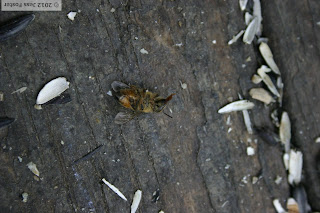Before looking at the photos, it might be helpful to study some simple anatomical diagrams:

These and other diagrams can be found at http://science.howstuffworks.com/environmental/life/zoology/insects-arachnids/bee1.htm. More complex diagrams can be found here: http://www.extension.org/pages/26467/illustrations-from-anatomy-of-the-honey-bee-by-re-snodgrass. On this site you can download (for free) the entire book by Robert E. Snodgrass.
Now, to the photos:
 |
| At this point I turned the bee over to get a better view of its underside. |
 |
| Now you can see more clearly the parts making up the bee's proboscis: moving inward, there are the maxillae, the labial palps, and the glossa, ending in the labellum. Consult http://chemse.oxfordjournals.org/content/early/2011/05/26/chemse.bjr040/F3.expansion.html#ref-103. |
Also check out:
http://bugguide.net/node/view/3080
http://www.slideshare.net/antamuk/european-honey-bee
http://www.biology-resources.com/bee-01.html










I found a bumblebee in the same state but still alive. It was unable to retract proboscis at all and only just able to slightly move its legs. I offered some sugar water and it was desperate for it, it took a while but perked up enough to be walking around but still could not retract proboscis. I fed with sugar water and although energy increased it never retracted proboscis or attempted to use it's wings. It declined over night and this morning it's legs were violently twitching out of control before dying.
ReplyDelete